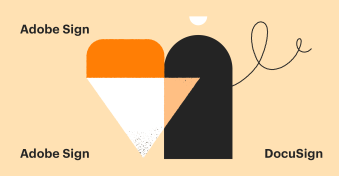In today’s business landscape, the ability to sign documents electronically and manage them efficiently is both essential and highly complex.
That’s more true than ever when working with European businesses who, thanks to eIDAS and similar regulations, adhere to a high standard of e-signature verification.
For businesses working in these markets, the ability to conform to these standards is essential.
YouSign and DocuSign are two leading players commonly utilized in European markets — but how do they actually measure up to one another?
In this article, we’ll explore the key differences between these two platforms and how they cater to common business needs.
Let’s get started.
Key takeaways
- YouSign offers an affordable, simple, and streamlined experience that works well for many businesses.
- DocuSign provides a more comprehensive suite of features and accommodates very complex document workflows.
- Both platforms prioritize security, compliance, and authentication to ensure the legality and integrity of signed documents.
YouSign
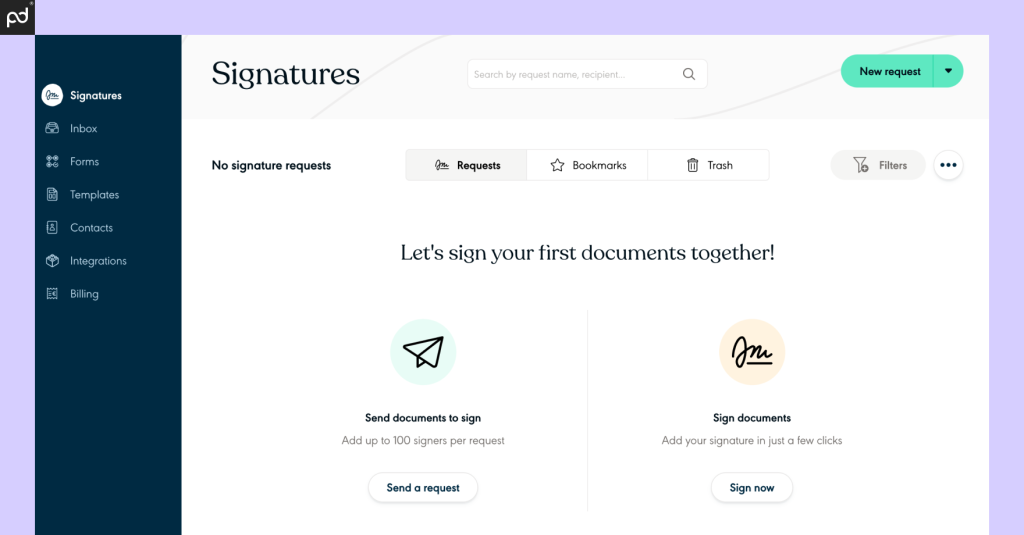
Pricing: One (€11); Plus (€30); Pro (€48). Pricing based on monthly commitment. Enterprise solutions available.
Ease of use: 9.5/10
Free trial: Yes; 14 days.
Support: Knowledge base; support tickets; phone.
YouSign is a user-friendly electronic signature solution specifically designed to meet the needs of European businesses.
The platform simplifies the e-signing process for both senders and signers, making it easy to get documents signed quickly and securely.
With a focus on ease of use, YouSign eliminates the learning curve often associated with more complex platforms.
The interface features intuitive controls meant to ensure a seamless experience for senders and signers alike.
Critically, YouSign is heavily focused on security and compliance.
As an eIDAS-certified provider, the platform can ensure that the signatures it provides adhere to strict European regulations, an important feature for global businesses.
However, YouSign may fall short for businesses with complex e-signature needs.
The platform is designed around simplicity, but some advanced features — including advanced workflow automations and deeper reporting / analytics — may fall short when compared to other platforms.
DocuSign
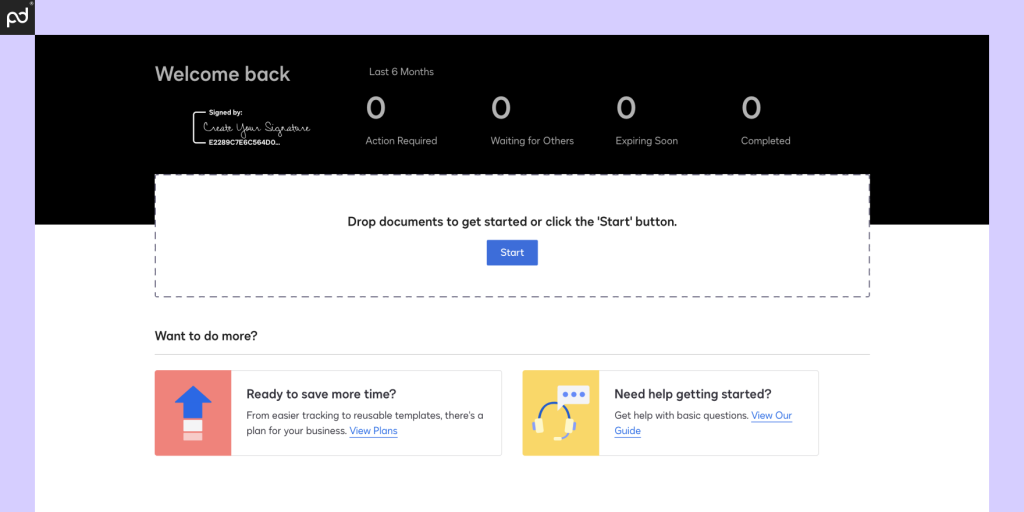
Pricing: Personal ($15); Standard ($45); Business Pro ($60). Enterprise pricing available. All pricing based on month-to-month commitment.
Ease of use: 9.0/10
Free trial: Yes; 30 days.
Support: Knowledge base; support tickets; additional support plans sold as separate packages.
DocuSign is a recognized leader in e-signatures, simplifying the signing process for real estate professionals. Its user-friendly platform and focus on security make it a trusted choice for handling sensitive documents.
In fast-paced real estate markets, DocuSign accelerates processes by enabling agents to streamline transactions, obtain signatures remotely, and reduce paperwork.
The platform also integrates with some popular real estate tools to further enhance efficiency.
On top of that, DocuSign is the National Association of Realtors’ platform of choice and provides exclusive benefits to NAR members.
All that being said, it’s worth pointing out that DocuSign is an industry agnostic platform.
While it can work for realtors and offers a select set of plans specifically for the industry, the lion’s share of the platform’s features and products are aimed at a broader audience.
This puts the platform at a disadvantage when compared with platforms designed to handle aspects of real estate that go beyond capturing secure digital signatures.
YouSign vs DocuSign at a glance
While we’ll get into the key differences between DocuSign and YouSign in the following sections, here’s a closer look at how these platforms compare at a high level.
| Plan Details | DocuSign | YouSign |
|---|---|---|
| Core product | ||
| E-signature capture | ✓ | ✓ |
| Real-time audit trail | ✓ | ✓ |
| Notifications | ✓ | ✓ |
| Language support | ✓ | ✓ |
| Mobile app | ✓ | X |
| Reporting tools | ✓ | X |
| E-signing features | ||
| Signing order | ✓ | ✓ |
| Send to multiple recipients | ✓ | ✓ |
| Bulk send | ✓ | ✓ |
| In-person signing | ✓ | ✓ |
| Collaboration tools | ✓ | ✓ |
| Signer attachments | ✓ | X |
| Payment gateway | ✓ | X |
| Document prep | ||
| Drag & drop fields (PDF) | ✓ | ✓ |
| Create reusable templates | ✓ | Unlimited |
| From-scratch document builder | X | X |
| Pre-built template library | X | X |
| Form creation | ✓ | $ |
| Custom branding | ✓ | ✓ |
| Integrations & API | ||
| Import & storage | ✓ | ✓ |
| CRM | X | Limited |
| Productivity | ✓ | Limited |
| API | $ | X |
| Support | ||
| Email / ticketing support | ✓ | ✓ |
| Chat support | X | X |
| Knowledge base | ✓ | ✓ |
| Phone | X | ✓ |
| Premium support options | $ | X |
In order to balance features with cost, the chart above compares DocuSign’s Business Pro plan with YouSign’s Pro plan.
When billed annually, both are available for roughly the same cost.
However, there are a few other important differences to consider when factoring for cost:
- DocuSign limits users to 10 sends per month and 100 envelopes per year.
- Additional sends beyond this limit will incur additional costs.
- YouSign’s advanced signature capabilities (AES and QES) and its form generation tools are only available as paid add-ons, further increasing costs.
These platform limitations will add additional considerations to your purchasing decision.
From the perspective of volume, DocuSign’s limitations are a net negative for power users, who may need to send more than DocuSign’s annual and monthly limits will allow.
While it’s possible to raise this limit by purchasing additional transactions, doing so can substantially increase plan costs.
On the other hand, YouSign only offers “simple” or “basic” signatures on all of its plans unless users purchase the add-ons for more advanced signature types.
This type of signature is usually legally binding but lacks the authenticity and validation of more advanced signatures.
Lower-tier YouSign plans only allow for simple signatures and cap the number of documents that can be sent via the platform each month.
To get truly unlimited e-signing, you’ll need to invest in the Plus or Pro plans.
If these add-ons and limitations sound needlessly complicated, PandaDoc may be a better solution.
At PandaDoc, we offer no-limit sending and secure e-signing tools on the market without the need for additional add-ons and upgrades.
For users who need it, we also offer qualified electronic signatures at $5 per verification.
Requirements, workflows & pricing
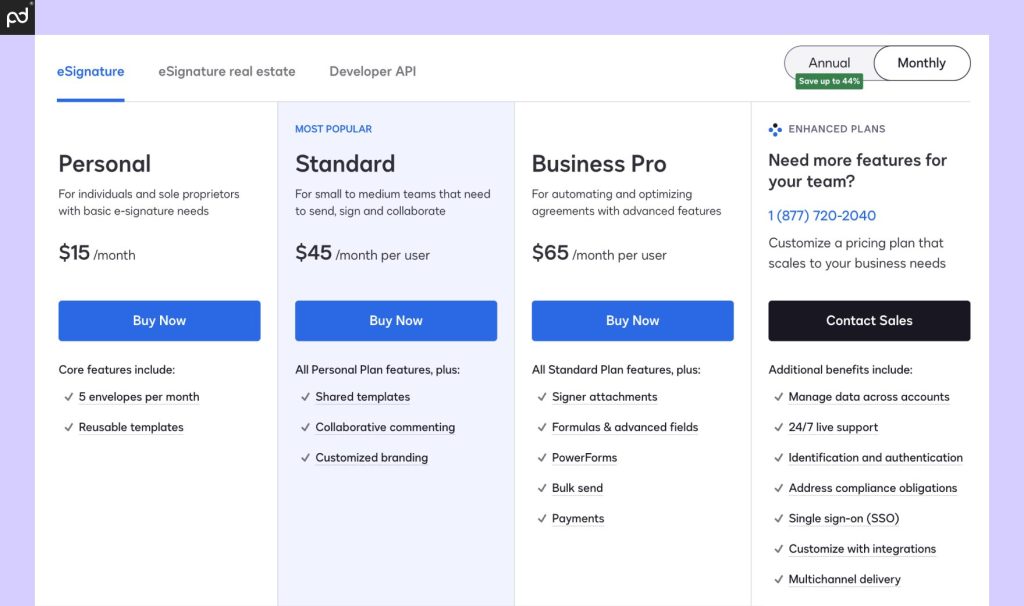
DocuSign and YouSign are similar products designed to fill the same spot in the document workflow, and both are focused on a combination of electronic signature capture and document management.
Regardless of which product you intend to use, you’ll follow roughly the same process.
Since neither DocuSign nor YouSign assist with document generation, users will need to create documents via a word processor like Microsoft Word or Google Docs prior to using the platform.
Once a document has been created and is ready for e-signature, users can upload their documents to the platform, assign recipients, and use drag-and-drop fields to prepare documents for e-signing.
It’s also possible to set a signing order or enable specific permission for document handling during the preparation phase.
Once the document is ready, preparers will send the document to assigned recipients via the platform.
Recipients will get an email notification, click the link, review the document, and sign electronically.
From within the user dashboard, senders can track document progress, send reminders, and view completed documents.
Signers will also be able to access and download completed documents using the signing link from their email.

YouSign and DocuSign are so similar, both in their use case and application, that it would be difficult to tell them apart if not for their own product design.
Some of the biggest differences between them come down to pricing and company size.
DocuSign, as an established leader in the industry, offers far more in terms of scope and capability than YouSign. The plans are more expensive, but they generally have more to offer in terms of integrations and functionality.
However, DocuSign’s advantages in terms of scope are offset by its envelope limits and usage restrictions, which YouSign doesn’t share.
On the other hand, users with YouSign should expect greater limitations around product features like bulk send and integrations — even on higher-end plans — in exchange for lower costs and fewer sending restrictions.
Our suggestion
On the surface, both DocuSign and YouSign offer a similar product and user experience.
The key differences between the two platforms are largely centered around the size and scale of the companies and the restrictions placed around product usage.
Because YouSign is a smaller company, the product sees more limitations around core functionality. Unfortunately, DocuSign places usage restrictions that drive up costs for moderate- to high-volume senders.
- DocuSign users will have a better selection of features but may feel restricted by usage caps.
- YouSign users have more flexibility around usage but may find a more limited product feature set.
- PandaDoc offers ways to combine e-signing capabilities and document creation with expanded features and no usage restrictions.
Workflow automations: templates & forms
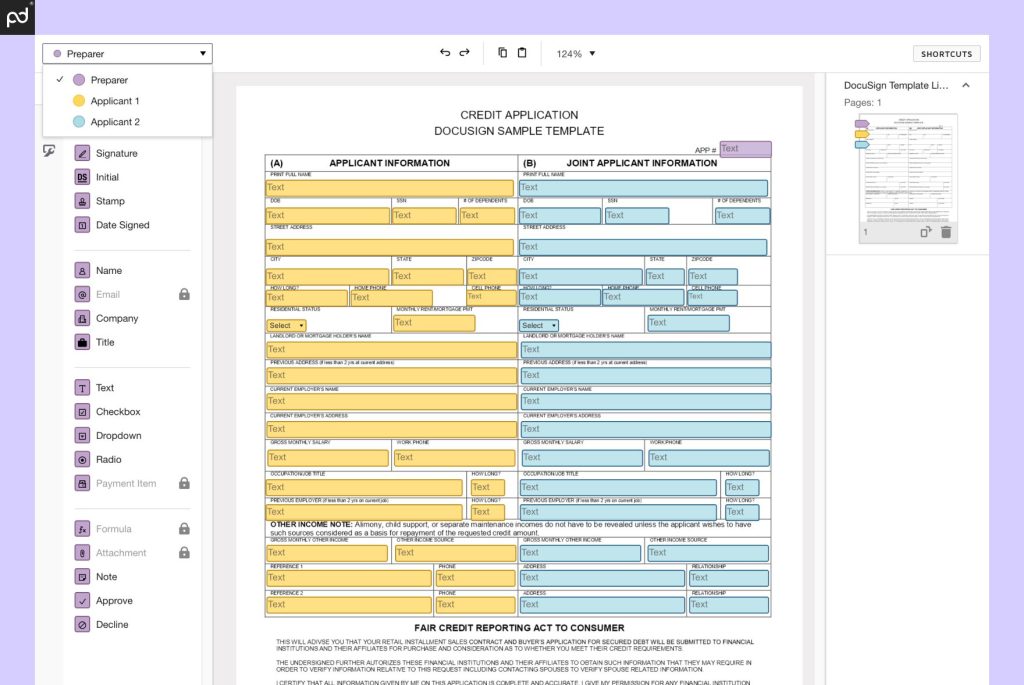
While both DocuSign and YouSign use similar drag-and-drop tools for document preparation, there are a few key differences in the platforms and how these elements are used.
On the surface, the experience is very similar.
Users will upload documents to the platform, prepare them by manually dragging data fields (text, date, checkbox, dropdown, etc.) onto the PDF version of the document.
For many documents, these preparatory steps will be all that is needed.
However, for users who want to do more with workflow automation, both platforms provide tools like template and form creation to assist with that.
DocuSign users have a notable advantage in this area. Regardless of plan, DocuSign users can create an unlimited number of templates to facilitate fast and easy document preparation.
Users will need to upload a finished version of the document, add the appropriate fields, and save the document as a template. From there, duplication is fast and easy.
At the Business Pro plan, DocuSign users also gain access to both Web Forms and PowerForms.
PowerForms are embeddable forms that can be loaded into a web page.
Essentially, these forms are generic document templates that any user can fill out when outside the DocuSign website.
Users will select a template, generate an embeddable code, and add that to the web page where they want the form to load. Anyone who visits the page can fill out the form, and the input data is sent back to the DocuSign account.
Web Forms are a newer type of interactive, mobile friendly form that are created using an interactive form builder (separate from DocuSign’s drag-and-drop document prep tools).
Utilizing these tools, users can create multi-page forms to streamline data capture of any type.

By comparison, YouSign offers a similar style of template creation but limits this functionality to higher-end plans. Plus and Pro plans gain access to unlimited templates, but the One plan is limited to a single template item.
Automated Forms also incur an additional charge on all but the higher-end Pro plan, but this add-on can be purchased on any paid plan starting at €10/month.
YouSign’s forms are closer to DocuSign’s Web Forms than PowerForms. With YouSign, users will need to create a form using variable fields in Microsoft Word.
Once the form is uploaded, YouSign will automatically create a fillable form based on the document variables that need to be answered.
Users can modify the questions to solicit the appropriate answers, which are then added to the uploaded form document.
While it’s possible to replicate this process in DocuSign, YouSign’s form conversion workflow is an interesting approach that is entirely unique to the platform.
Our suggestion
If you’re trying to automate your workflow using forms and templates, both DocuSign and YouSign have a few interesting tricks to offer.
DocuSign’s Web Forms are a newer, more modern type of form that rely on a separate builder and preparation process. However, the platform’s PowerForms, while still useful in niche circumstances, feel antiquated and aren’t a good fit for mobile form generation.
On the other hand, YouSign offers an innovative approach to form generation by automating the form creation process based on document variables.
This takes some practice to fully understand, and you’ll probably need to test it out a few times to learn how the variable-to-form conversion works.
It’s also worth pointing out that form generation isn’t exclusive to DocuSign or YouSign.
Other platforms also offer form generation options that fall somewhere between what DocuSign and YouSign offer.
- DocuSign offers unlimited templates on all plans, as well as two separate form types and a dedicated form builder.
- YouSign limits unlimited templates to higher-end plans and provides a form builder that automatically generates forms based on variables from uploaded documents.
- PandaDoc provides unlimited templates and integrates form building with its onboard document builder, allowing for seamless, onboard form creation.
Integrations & extensibility
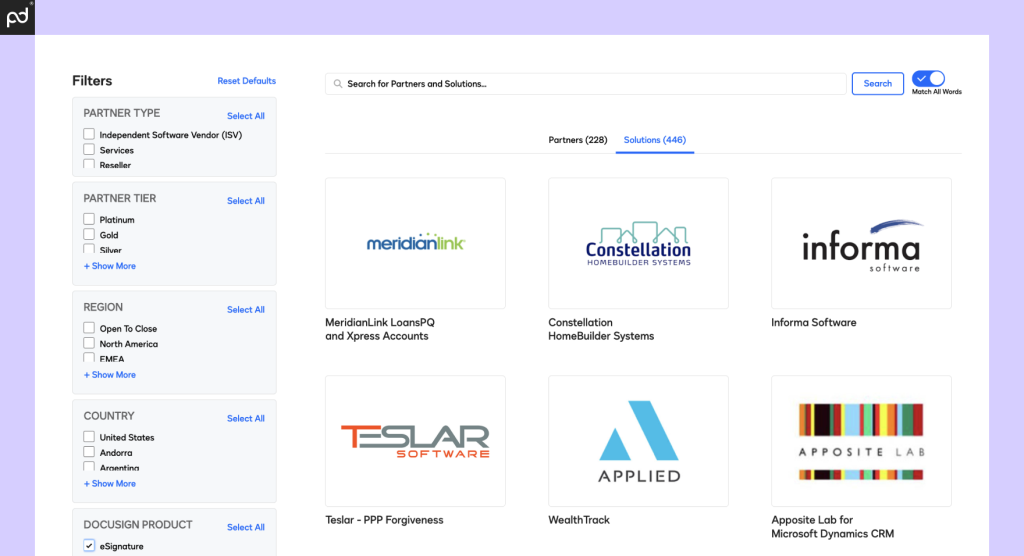
For many companies, the ability to integrate an e-signing platform with the rest of the document workflow is a must.
This is particularly true for small businesses, where building a seamless workflow can give a single user a broad range of control over a departmental process.
Unfortunately, the deck is stacked heavily in favor of DocuSign in this regard.
DocuSign boasts a vast ecosystem of integration options, making it a seamless fit for both small businesses and major corporations.
The platform’s open API (separate plan required) allows developers to build custom integrations with virtually any application, giving businesses the flexibility to tailor the platform to their unique needs.
Additionally, DocuSign offers pre-built connectors for popular CRM, ERP, and productivity tools like Salesforce, Microsoft Dynamics, and Google Workspace, enabling efficient data flow and streamlined workflows.
This extensibility makes DocuSign a powerful solution for automating and enhancing various business processes, from sales contracts to HR onboarding.
While many competing platforms offer extensive integration libraries, nothing compares to DocuSign in this regard.
Plus, while DocuSign reserves a handful of top integrations for its enterprise users (notably: Salesforce), the vast majority of its integration library is available for all users on all plans.
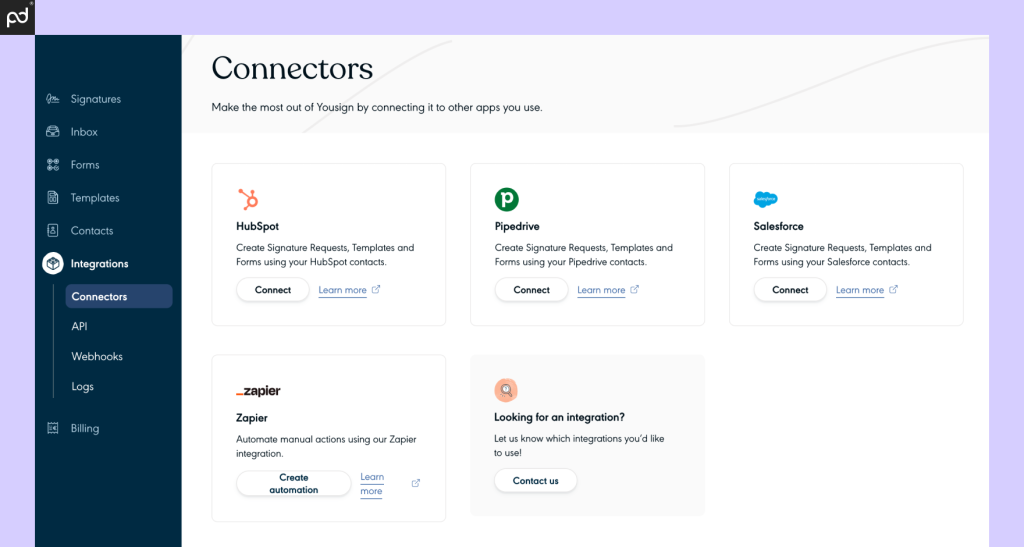
Comparatively, YouSign only offers a handful of integrations, and can’t compete with DocuSign.
YouSign integrates primarily with Zapier on its higher end plans, although it does have a few native connectors available that allow for document uploads.
Its API also enables custom integrations, although the scope might be less extensive compared to DocuSign.
YouSign’s lack of competitiveness in this area means that the platform is largely a product that will stand alone from the rest of the document workflow.
Unlike DocuSign or PandaDoc, which offers integrations with many CRM tools and can integrate directly with Microsoft Word or Google Workspace (great for SMBs!), teams will need to manually upload and manage documents in YouSign after tasks have been completed in other apps.
While this lack of connectivity isn’t necessarily a major blow to the platform’s effectiveness, it does mean that YouSign can’t become part of a seamless workflow experience without a 3rd party connector — Zapier — which incurs extra fees and charges and may only offer limited functionality.
Our suggestion
If your business requires extensive integrations with a wide array of applications and the ability to create highly customized workflows, platforms like DocuSign or PandaDoc might be the better choice.
YouSign may still be a more suitable option if you’re comfortable with manually switching to a separate platform for e-signing and form creation.
- DocuSign offers hundreds of native integration options, allowing for turnkey e-signing functionality as part of almost any document workflow.
- YouSign only provides limited connectivity, meaning the platform will largely stand apart from the rest of the document workflow.
- PandaDoc users can enjoy integration with modern word processing tools and CRMs or can simply create documents with the onboard document creator and sidestep the connectivity conversation entirely.
Security & compliance
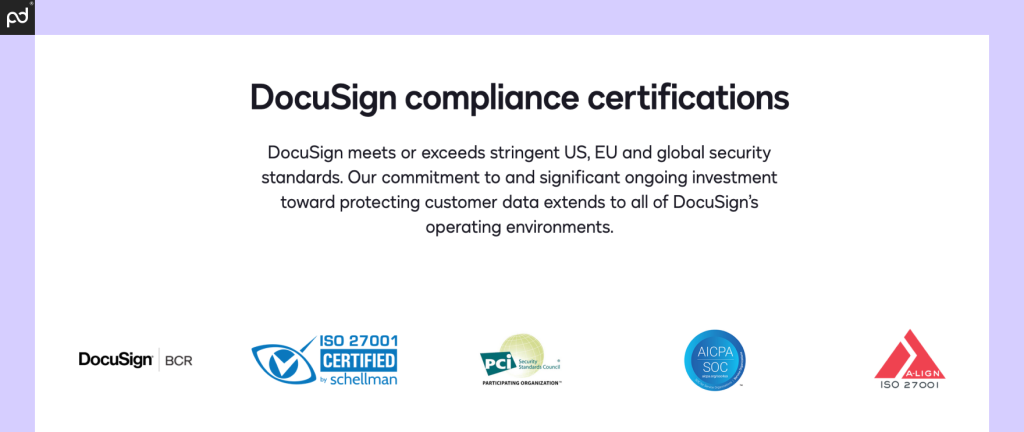
Both DocuSign and YouSign are notable for their attention to document security and regulatory compliance for electronic signatures.
As a global leader in e-signatures, DocuSign prioritizes security and compliance across its platform. Like PandaDoc, DocuSign adheres to a multitude of international standards and certifications, including ISO 27001, SOC 2 Type II, and HIPAA, making it suitable for businesses operating in various regions with stringent regulatory requirements.
The platform also employs robust encryption protocols, multi-factor authentication, and detailed audit trails to ensure document integrity and protect sensitive information.
Its comprehensive approach to security fosters trust and confidence in digital transactions.
However, as a US-based company, most of DocuSign’s regulatory compliance is centered around US law.
While the digital signatures that DocuSign provides are compliant with eIDAS regulation, the language and terminology surrounding DocuSign’s e-signatures isn’t the same as what you’ll see with a European company like YouSign.
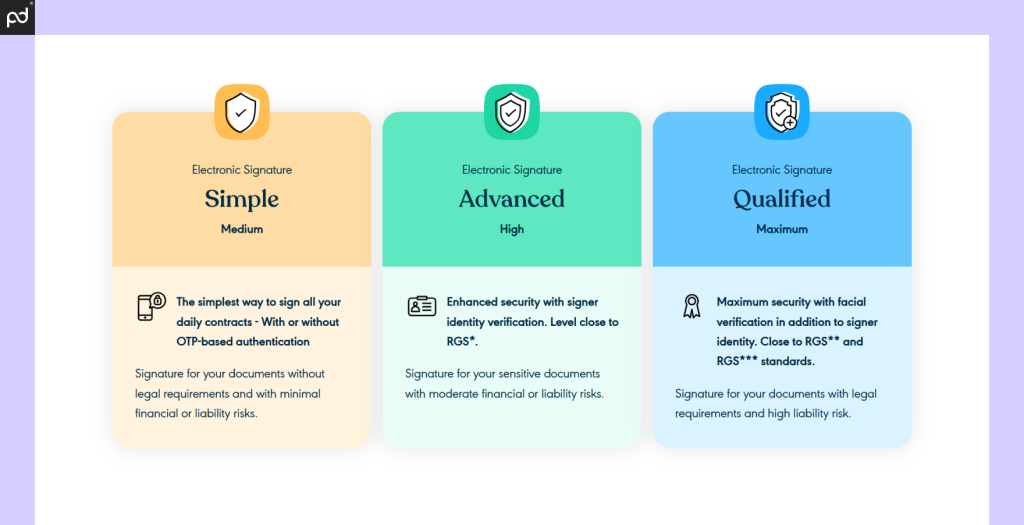
YouSign, while maintaining a strong focus on security, tailors its compliance efforts specifically to European regulations.
As an eIDAS-certified provider, YouSign ensures that its platform meets the stringent requirements of the European Union’s electronic identification and trust services regulation.
This makes YouSign an ideal choice for businesses primarily operating within the EU, guaranteeing legal validity and data protection in accordance with local standards.
YouSign also employs essential security features like encryption, audit trails, and authentication, safeguarding documents and user data.
However, the notable downside to YouSign’s approach is that advanced and qualified e-signature types require a plan add-on. Without these upgrades, YouSign only provides simple electronic signatures with limited identity verification.
This effectively means that DocuSign’s standard digital signatures — roughly the equivalent of an advanced signature by eIDAS regulations — are more secure than the baseline signature captured on the YouSign platform.
At the highest level, YouSign offers native recognition tools for qualified e-signing that you won’t find with DocuSign or PandaDoc.
YouSign’s onboard facial recognition can validate signers quickly and without the use of third-party apps (used by other signing platforms in order to achieve eIDAS compliance).
If you’re seeing a seamless process for the most secure type of electronic signature in Europe, YouSign can do it all.
Our suggestion
Both DocuSign and YouSign offer robust security and compliance features, making them reliable choices for businesses handling sensitive information.
If your operations are primarily focused within the European Union, YouSign’s dedicated adherence to eIDAS regulations might provide a more streamlined and tailored solution.
On the other hand, if your business operates globally and requires compliance with a broader range of international standards, DocuSign’s comprehensive security framework and certifications might be a better fit.
- Global platforms like DocuSign and PandaDoc offer top-notch security and compliance, as well as globally recognized, secure electronic signatures.
- YouSign provides all the tools required for eIDAS compliance, but additional costs are required.
Alternatives to YouSign & DocuSign
Is DocuSign too expensive? Does YouSign seem too simple? While both e-signature providers excel at what they do, they aren’t the only SaaS companies on the market who can distribute digital signatures.
Here’s a quick list of other user-friendly tools that you can use to sign documents with ease:
- PandaDoc.
- Dropbox Sign (formerly HelloSign).
- Adobe Acrobat Sign (formerly Adobe Sign).
- OneSpan Sign.
- SignNow.
Despite the number of competitors, it’s worth pointing out that YouSign and DocuSign both hold rare positions as an e-signature solution in that they’re both eIDAS compliant platforms capable of delivering QES signatures when partnering with regional distributors.
Most other competitors in the market — especially e-signature apps based in the US market — may no include this functionality since it’s a need exclusive to European markets.
Alternative solutions do exist.
For example, PandaDoc helps users generate compliant QES signatures anywhere in the world using third-party trusted service providers.
Keep these qualifications in mind when considering alternative electronic signature solutions.
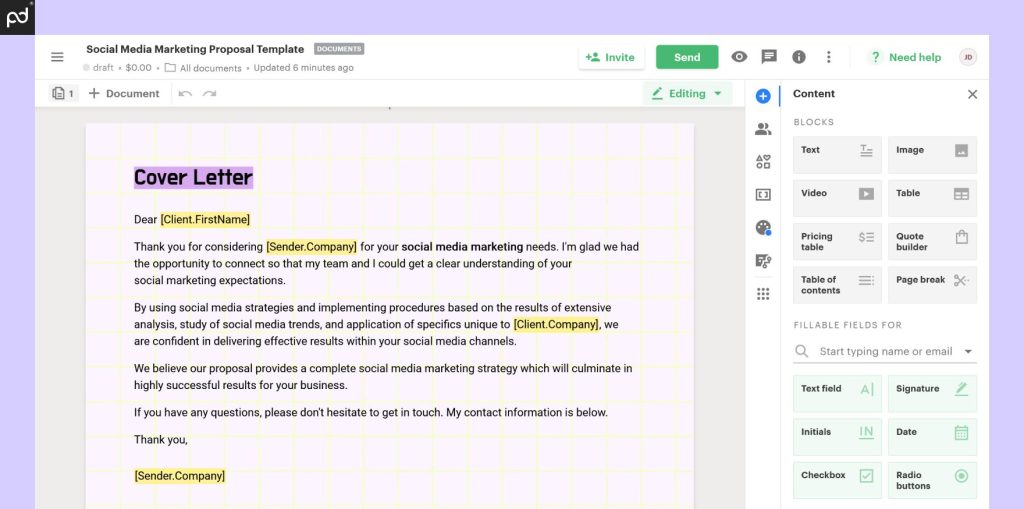
Enjoy end-to-end document control — with PandaDoc
While DocuSign and DocSend are valuable tools for e-signing and form generation, PandaDoc offers a more comprehensive and efficient solution.
Our all-in-one document platform enables users to create, send, and e-sign a variety of documents all in one place.
You can even integrate with dozens of CRM and productivity tools to connect document creation to the rest of your tech stack.
Beyond documents, PandaDoc can with dynamic form creation, approval workflows, and much more.
Plus, our dedicated mobile apps for Android and iOS allow you to manage documents on the go anywhere, anytime.
Check out PandaDoc with a free 14-day trial or schedule a personalized demo to see how our platform can change the way your team works with essential documents.
Disclaimer
PandaDoc is not a law firm, or a substitute for an attorney or law firm. This page is not intended to and does not provide legal advice. Should you have legal questions on the validity of e-signatures or digital signatures and the enforceability thereof, please consult with an attorney or law firm. Use of PandaDoc services are governed by our Terms of Use and Privacy Policy.
Originally published August 30, 2022, updated August 30, 2024
